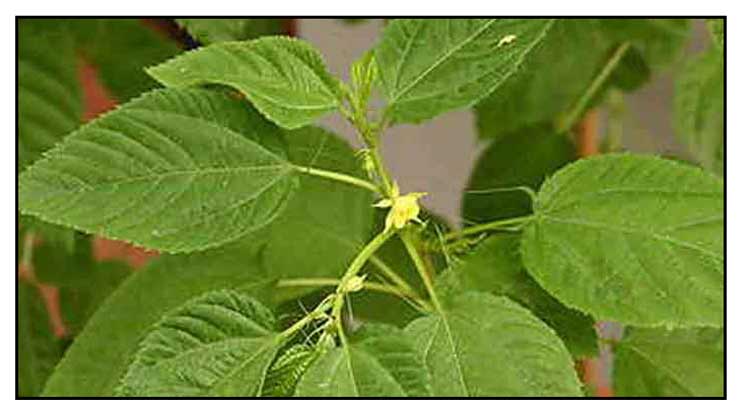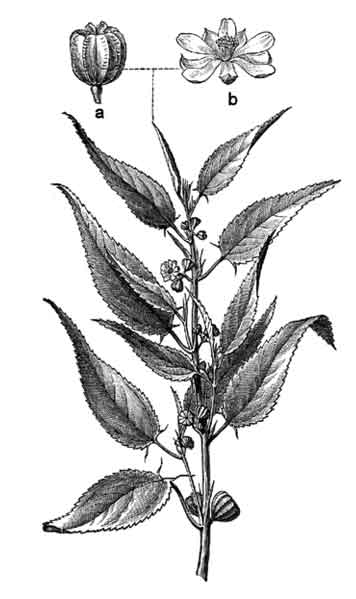 Gen
info Gen
info
Corchorus is a genus plant
of about 40-100 species in the family Malvaceae. Jute is confusingly
applied to any plant of the genus Corchorus and to its fiber. The chief
sources of the fiber are the two species of Corchorus plant: C olitorius
and C capsularis. In the Philippines, three Corchorus species
are recorded with medicinal uses: Pasau, Pasau na bilog,
and pasau na hapai. Another pasau, Pasau-na-hapai, Jussiaea
erecta belongs to the family Onagraceae.
 Botany Botany
Pasau-na-bilog is an erect, branched annual
herb, growing up to 1 to 2 meters high. Stems are usually purplish. Leaves are ovate-lanceolate,
5 to 12 centimeters long, pointed at the tip and rounded at the base, with toothed
margins and tail-like projections on the each side of the midrib. Flowers are in small groups in the axils of the leaves, about 4 millimeters long. Sepals are often purplish and the petals are yellow.
Capsules are globose to globose-obovoid, about 1 centimeter in diameter, with longitudinal ridges.
Distribution
- In clearings,
rice paddy banks, and in low, open and usually wet places in and near settlements, throughout the Philippines.
- Pantropic.
- Not cultivated in the Philippines.
- Cultivated in China, India, Bangladesh for its fiber.
Constituents
- Active principle of the jute seed is corchorin, a glucoside ten
times more bitter than quinine sulfate.
- Leaves yield a bitter compound, capsularin,
a compound with the same molecular formula and melting point as corchorin.
- From the leaves, capsularin, with the same molecular formula
as corchorin.
- Study yielded corchortoxin, another cardiac agent from the seeds.
- Study yielded another bitter, corchsularin from the seeds.
(9)
- Seed contains 2.25 percent of raffinose.
- Oil contains the glycerides of oleic acid, 39.18%; glycerides of linoleic acid, 44.63 %; a small quantity of "crude arachidic acid," 0.169%; and palmitic and stearic acid.
- Leaves yielded a glycoside–capsugenin-30-o-B-glycopyranoside. (5)
- Study of lipid and lignin composition of jute fibers showed the lipophilic compounds as high molecular weight ester waxes (24% of total extract), free fatty acids (17%), free fatty alcohols (17%), and α-hydroxy fatty acids (14%), with significant amounts of alkenes (6%), co-hydroxy fatty acids (6%), sterols (6%), steroid and triterpenoids ketones (3%), and steryl glycosides (1%). (10)
 Properties Properties
- Considered carminative, cardiac, laxative, febrifuge,
and tonic.
- Leaves considered stimulant, laxative, demulcent, appetizer and stomachic.
- The corchorin considered toxic and poisonous; some studies suggest a digitalis-effect
on the heart.
- Fiber, one of nature's stronger vegetable fibers, is referred to as the "golden fiber."
It is long, soft, shiny, 1 to 4 meters in length, with a diameter of 17 to 20 microns, with high insulating and anti-static properties, with moderate moisture regain and low thermal conductivity.
- Studies have suggested antipyretic, anti-inflammatory, and analgesic, insecticidal, antioxidant properties.
Parts used
Seeds and leaves.
Uses
Edibility / Nutrition
- Edible: Leaves and seeds.
- In the Philippines, tops eaten as vegetable, particularly by the Ilocanos who call it "saluyut."
Young fresh leaves eaten as vegetable in various parts of the world - Bangladesh, Middle East, Africa, SE Asia.
- In Bengal, where it is considered a tonic, leaves are used as a condiment, commonly added to the daily diet of rice.
- In Japan, considered a health food item, dried leaves sometimes used as a substitute for coffee and tea
Leaves sometimes used as condiment.
- In Rumpf's time, when slaves from India were detained in Amboina, there was much use for it as vegetable.
Folkloric
- Leaves are used for headaches.
- Seeds, either as power or decoction, used as tonic, carminative
and febrifuge.
- In Bengal,
decoction of dried leaves used for disorders of the liver.
- Malays use a decoction of the leaves for dysentery, for coughs and phthisis, and as a tonic for children. Also, used for poulticing sores.
- The powdered leaves, dried, 1 or 1 1/2 tbsp to a cup of water, steep
for 3 to 5 minutes, and strain before drinking.
- Leaves used as stomachic.
- Finely carded fiber sometimes used as base for antiseptic surgical dressings.
- Infusion of leaves used for atonic dyspepsia, liver disorders and as febrifuge. Also used for chronic cystitis, gonorrhea, dysuria, worms in children, hepatic and intestinal colic, and for gastric catarrh.
- Cold infusion of the leaves as a bitter tonic; used in patients recovering from acute dysentery
- A compound infusion of the leaves with coriander and anis seed is
an effective bitter stomachic and tonic.
- Poultice of leaves for sores.
- Six grains of the powder combined with equal amounts of Curcuma longa used for acute dysentery.
- A compound infusion of the leaves with coriander and anis seed used as an effective bitter, stomachic and tonic.
- Bitter seeds given in small doses (60-80 grain dose) for fevers.
- Oil from seeds is used for a variety of skin diseases.
- Fruits used by Sino-Annamites for inflammation, abscesses and as purgative.
- In Bengal, oil from the seeds used for skin diseases.
- In Sindh medicine, plant is burned and mixed with oil and used for 8 days to treat alopecia. Used in the treatment of piles, tumor, dysuria, fever, gonorrhea, and ascites.(19)
Others
Commerce of Jute
-
The species provides the greatest part of the jute commerce (burlap, cordage, gunny), with its strong and coarse fiber, about ten times more abundant than Corchorus olitorius, another source of jute. Jute yarn has replaced flax and hemp in sackcloth. Sacking is the bulk of manufactured jute products. The yarn is also used in weaving curtains, chair coverings, carpets, and rugs. It is blended with other fibers in making toys, decorative wall hangings, lamp shades and shoes. Also used for rigid packaging, reinforcing plastic, and replacing wood in pulp and paper.
- Finely carded and highly absorptive fiber used as basis for antiseptic surgical dressings.
- Used for paper making.
Studies
• Antinociceptive
/ Anti-Inflammatory / Leaves: Study
evaluated C. capsularis leaf chloroform extract showed significant (p<0.05) antinociceptive and anti-inflammatory activities in experimental animal models. Results confirm its traditional use for ailments associated with
inflammation and pain. (1)
• Galactolipid / Anti-Tumor: Galactolipid
1 has be shown to be responsible for the anti-tumor promoting activity
of jute (Corchorus capsularis and C. olitorius). (2)
• Antipyretic / Antinociceptive / Anti-Inflammatory:
Study on the aqueous extract of jute plant leaves, C. capsularis,
exhibited significant antinociceptive, anti-inflammatory and antipyretic
activities in a dose-dependent manner and supports its claim of traditional
use to treat various ailments.
(4)
• Capsugenin / Leaves: Study yielded a glycoside–capsugenin-30-o-B-glycopyranoside, from
the leaves of Corchorus capsularis. (5)
• Cardiotonic Activity / Seeds:Study of seeds isolated a cardiac glycoside chorchortoxin (strophanthidin), a cardiac glycoside that showed cardiotonic activity similar to the digitalis genus. (12)
• Antimicrobial / Insecticidal: Study evaluated different seed extractives of C. capsularis for antimicrobial and insecticidal activities. All fractions and isolated compounds showed antimicrobial and insecticidal activities against four pathogenic bacteria i.e. V. cholerae, Shigella spp., Salmonella spp., E. coli and the insect T. castaneum. Crude extract showed highest antibacterial activity with inhibition zone of 26-27 mm. In insecticidal activity, the PE fraction showed highest toxicity. (13)
• Chemical Composition of Jute Fibers for Paper Pulp Manufacturing:Study characterized the lipid and lignin composition of jute fibers. The most prominent lipophilic compounds were high molecular weight ester waxes (24%) followed by free fatty acids (17%), free fatty alcohols (17%), and
α-hydroxyfatty acids (14%). There were significant amounts of alkanes, ω-hydroxyfatty acids, sterols, steroid and triterpenoid ketones, and steryl glycosides. (14)
• Caffeine & Catechin / Antioxidant and Cytotoxicity: Study reported on the isolation of caffeine and catechin from C. capsularis leaves extract. The isolated caffeine showed good antioxidant activity with IC50 of 285 µg/ml and showed moderate cytotoxic effect on Brine shrimp assay. The isolated catechin showed antioxidant effect with IC50 of 432 µg/ml with a total phenol content of 44.25 mg/g. The study sought to establish another new natural source of caffeine and catechin other than tea or coffee. (15)
• Antioxidant Effect: Crude methanolic extract of C. capsularis leaves and fractions were evaluation for free radical scavenging activity against DPPH and superoxide anion radical scavenging assays. Results showed remarkable antioxidant activity in both assays. Hexane extract showed the most potent antioxidant activity with 65.44-97.43% inhibition, followed by butanol, methanol and EA extracts. (12)
• Antitumor Promoting Activity / Fresh Leaves: Study of fresh leaves by immunoblotting analysis isolated two active components which showed activity against tumor promoter-induced Epstein-Barr virus (EBV( activation in Raji cells, and identified as phytol (3,7,11,15-tetramethyl-2-hexadecen-1-ol and monogalactosyl-diacylglycerol (1,2-d1-a-linolenoyl-3-ß-Dgalactopyranosyl-glycerol). Both components increased in the period of treatment with hot water, indication they were not easily decomposed by high temperature, and suggests that treatment of the vegetable with hot water may increase the amount of activity components. (•) Another study showed insufficient inhibitory effects by both compounds at concentrations of 10µg/ml and 25 µg/ml. (Furumoto et al, 2002; Meara and Sen, 1952; Zainul et al, 2007) (16)
• Antileishmanial Activity / Leaves: Study evaluated Corchorus capsularis leaf extract as an effective leishmanicidal substitute against Leishmania donovani. The leaf extract showed potent antileishmanial activity against L. donovani promastigotes with IC50 of 79.00 ± 0.3 µg/ml. The extract also significantly induced intracellular reactive oxygen species (ROS). (17)
• Antileishmanial / Trypanothione Reductase / ß-Sitosterol: Current antileishmanial drugs exhibit toxicity and resistance-related issues. Chemotherapeutic alternatives are in demand. Study reports that a chloroform extract of leaves exhibits a significant effect against Leishmania donovani promastigotes. Bioassay-guided fractionation yielded a leaf-derived ß-sitosterol. The inhibitory effect of ß-sitosterol against L. donovani promistagotes was evaluated and showed it significantly disrupted the redux balance via intracellular ROS production, which triggers various apoptotic events, such as structural alteration, increased storage of lipid bodies, mitochondrial membrane depolarization, externalization of phosphatidylserine and non-protein thiol depletion in promastigotes. The anti-leishmanial activity was validated by enzyme inhibition and an in-silico study ß-sitosterol inhibited L. donovani trypanothione reductase. The Corchorus capsularis ß-sitosterol appears to have potential as a novel inhibitor of the LdTryR and may have a place in the treatment of visceral leishmaniasis, its deadliest clinical form. (20)
• Gastroprotective / Ethanol-Induced Acute Mucosal Lesion / Leaves: Study evaluated the protective effect of C. capsularis leaf extract on ethanol-induced acute gastric mucosal lesion (AGML) in Sprague-Dawley rats. Total polyphenol, flavonoid, and polysaccharide were 59.88, 86.39. and 320.89 mg/g, respectively. Results showed significant dose-dependent decrease in the ulcer index. There was also improvement in serum lipid parameters with increase in glutathione peroxidase, suprtoxide dismutase, and catalase, and a decrease in malondialdehyde. There was also amelioration of pathological score. Protective effects were attributed to antioxidant activity. (21)
Availability
Wild-crafted. |



